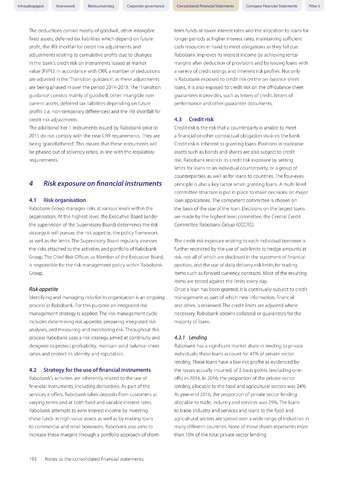4 Risk exposure on financial instruments
Inhoudsopgave Voorwoord Bestuursverslag Corporate governance
The deductions consist mostly of goodwill, other intangible
fixed assets, deferred tax liabilities which depend on future
profit, the IRB shortfall for credit risk adjustments and
adjustments relating to cumulative profits due to changes
in the bank's credit risk on instruments issued at market
value (FVPL). In accordance with CRR, a number of deductions
are adjusted in the Transition guidance', as these adjustments
are being phased in over the period 2014-2018. The Transition
guidance'consists mainly of goodwill, other intangible non-
current assets, deferred tax liabilities depending on future
profits (i.e. non-temporary differences) and the IRB shortfall for
credit-risk adjustments.
The additional tier 1 instruments issued by Rabobank prior to
2015 do not comply with the new CRR requirements.They are
being 'grandfathered'. This means that these instruments will
be phased out of solvency ratios, in line with the regulatory
requirements.
4.1 Risk organisation
Rabobank Group manages risks at various levels within the
organisation. At the highest level, the Executive Board (under
the supervision of the Supervisory Board) determines the risk
strategy it will pursue, the risk appetite, the policy framework
as well as the limits.The Supervisory Board regularly assesses
the risks attached to the activities and portfolio of Rabobank
Group. The Chief Risk Officer, as Member of the Executive Board,
is responsible for the risk management policy within Rabobank
Group.
Risk appetite
Identifying and managing risks for its organisation is an ongoing
process at Rabobank. For this purpose an integrated risk
management strategy is applied. The risk management cycle
includes determining risk appetite, preparing integrated risk
analyses, and measuring and monitoring risk.Throughout this
process Rabobank uses a risk strategy aimed at continuity and
designed to protect profitability, maintain solid balance-sheet
ratios and protect its identity and reputation.
4.2 Strategy for the use of financial instruments
Rabobank's activities are inherently related to the use of
financial instruments, including derivatives. As part of the
services it offers, Rabobank takes deposits from customers at
varying terms and at both fixed and variable interest rates.
Rabobank attempts to earn interest income by investing
these funds in high-value assets as well as by making loans
to commercial and retail borrowers. Rabobank also aims to
increase these margins through a portfolio approach of short-
Consolidated Financial Statements Company Financial Statements Pillar 3
term funds at lower interest rates and the allocation to loans for
longer periods at higher interest rates, maintaining sufficient
cash resources in hand to meet obligations as they fall due.
Rabobank improves its interest income by achieving rental
margins after deduction of provisions and by issuing loans with
a variety of credit ratings and inherent risk profiles. Not only
is Rabobank exposed to credit risk on the on-balance sheet
loans, it is also exposed to credit risk on the off-balance sheet
guarantees it provides, such as letters of credit, letters of
performance and other guarantee documents.
4.3 Credit risk
Credit risk is the risk that a counterparty is unable to meet
a financial or other contractual obligation vis-a-vis the bank.
Credit risk is inherent to granting loans. Positions in tradeable
assets such as bonds and shares are also subject to credit
risk. Rabobank restricts its credit risk exposure by setting
limits for loans to an individual counterparty, or a group of
counterparties, as well as for loans to countries. The four-eyes
principle is also a key factor when granting loans. A multi-level
committee structure is put in place to make decisions on major
loan applications. The competent committee is chosen on
the basis of the size of the loan. Decisions on the largest loans
are made by the highest level committee, the Central Credit
Committee Rabobank Group (CCCRG).
The credit risk exposure relating to each individual borrower is
further restricted by the use of sub-limits to hedge amounts at
risk, not all of which are disclosed in the statement of financial
position, and the use of daily delivery risk limits for trading
items such as forward currency contracts. Most of the resulting
items are tested against the limits every day.
Once a loan has been granted, it is continually subject to credit
management as part of which new information, financial
and other, is reviewed.The credit limits are adjusted where
necessary. Rabobank obtains collateral or guarantees for the
majority of loans.
4.3.1 Lending
Rabobank has a significant market share in lending to private
individuals; these loans account for 47% of private sector
lending.These loans have a low risk profile as evidenced by
the losses actually incurred, of 3 basis points (excluding one-
offs) in 2016. In 2016, the proportion of the private sector
lending allocable to the food and agricultural sectors was 24%.
At year-end 2016, the proportion of private sector lending
allocable to trade, industry and services was 29%. The loans
to trade, industry and services and loans to the food and
agricultural sectors are spread over a wide range of industries in
many different countries. None of these shares represents more
than 10% of the total private sector lending.
193 Notes to the consolidated financial statements

